River Exe: Difference between revisions
No edit summary |
|||
| Line 16: | Line 16: | ||
**[[Exford]] | **[[Exford]] | ||
**[[Exton, Devon|Exton]] | **[[Exton, Devon|Exton]] | ||
**[[ | **[[Exebridge]] | ||
*Devon: | *Devon: | ||
**[[Up Exe]] | **[[Up Exe]] | ||
| Line 23: | Line 23: | ||
**[[Exeter]] | **[[Exeter]] | ||
**[[Exminster]] | **[[Exminster]] | ||
**[[Exmouth]] | **[[Exmouth]] | ||
==Shape of the river== | ==Shape of the river== | ||
Latest revision as of 21:31, 7 September 2018
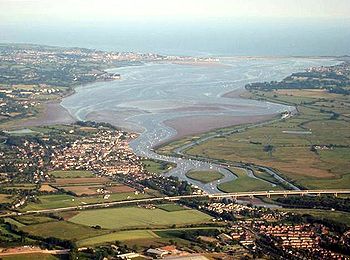
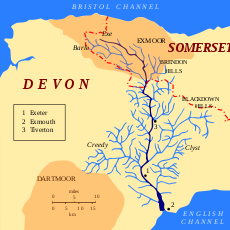
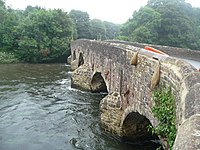
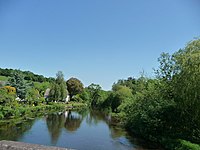
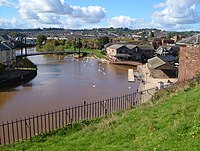
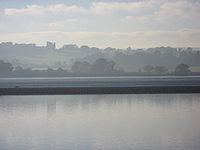
The River Exe rises at Exe Head near the village of Simonsbath, on Exmoor in Somerset, near the Bristol Channel coast, but flows more or less directly due south, so that most of its length lies in Devon.
The Exe reaches the sea at a substantial ria, the Exe Estuary, which opens into the English Channel. From Roman days until the late twentieth century the river's lowest bridging point was at Exeter, but there is now a viaduct for the M5 motorway about 2 miles south of the city centre.
Name of the river
The river's name derives from the ancient British language. The Romans knew it as Isca (a name also given to Exeter), which is believed to mean simply water.[1] This is one of many rivers throughout Great Britain of essentially the same name, usually appearing as the "Esk", and also as the Usk in Monmouthshire and another River Exe, in Hampshire, is now known as the Beaulieu River.
The river gives a name to Exmoor and to:
Shape of the river
The Exe is a moorland river in Somerset, running between the hills of Exmoor and gathering brooks as it goes. At Exbridge the river enters Devon, and is joined by the River Barle.
In Devon the Exe forges a broad, green valley, the Exe Valley southwards through east Devon. The first sizable town on the river is Tiverton, where it is joined by the River Lowman and the Grand Western Canal branches off, heading for the River Tone.
Further south the Exe comes to the city of Exeter, once a great port on the river. The river fuelled Exeter's growth and relative importance in mediæval times, and the city's first industrial area was developed at Exe Island, created by a series of leats to the west of the city. The island was home to numerous watermills producing paper and textiles; it also created valuable land through drainage of the marshlands.[2]
Countess Wear was built across the river in the 13th century, commissioned by the Countess of Devon, and at once it prevented ships from sailing up to Exeter and closed its port.[3] The Exeter Canal bypasses this weir to enable ships to reach Exeter Quay.
Below Countess Weir, the Exe is tidal and at high tide, the estuary forms a large body of water that is heavily used for water sports especially sailing, windsurfing and water skiing.
At the mouth of the river as it enters the sea, Exmouth stands at the east side of the estuary mouth, a seaside resort town, and Dawlish Warren stands at the west. A long sand spit extends from Dawlish Warren almost across the rivermouth.
Railways run along both sides of the estuary. The Avocet Line from Exeter to Exmouth on the eastern side, and the South Devon main line on the western. The latter is on a causeway, the South Devon Railway sea wall from Powderham to Dawlish Warren. The Exmouth to Starcross Ferry carries passengers across the mouth of the estuary during the summer months, linking the harbour at Exmouth with a pier adjacent to Starcross railway station on the South Devon main line.
Wildlife
At low tide, extensive mud flats are exposed, and these are an important feeding source for wading birds. Along with other rias in South West England, the Exe estuary is an important site for wintering waders. Dawlish Warren is a favoured site for birdwatching. The river is acidic and populated with wild brown trout and some grayling, the average size being 8-10 oz. Unlike many West Country rivers there are no seatrout, but there is a run of Atlantic salmon. Just 500 feet below the union of the River Barle is Black Pool, which is one of the best, and highest salmon pools on the river.
2008 cleansing operation
In 2008 the Environment Agency embarked on a project to clean the river from vegetation forming. In order to do so the water level decreased to its lowest level – less water remained than the droughts the city has suffered.[4]
References
- ↑ Eilert Ekwall (1981). The Concise Oxford Dictionary of English Place-names. Oxford [Eng.]: OUP. pp. 171. ISBN 0 19 869103 3.
- ↑ "Exeter Memories - the Leats of Exeter". www.exetermemories.co.uk. http://www.exetermemories.co.uk/EM/exeter_leats.html. Retrieved 2008-03-14.
- ↑ "Exeter Memories - Countess Wear". www.exetermemories.co.uk. http://www.exetermemories.co.uk/EM/_areas/countesswear.php. Retrieved 2008-03-12.
- ↑ "River Exe runs dry to make way for Flood Defence Work". www.thisisexeter.co.uk. http://www.thisisexeter.co.uk/displayNode.jsp?nodeId=137199&command=displayContent&sourceNode=136986&contentPK=19727600&folderPk=79934&pNodeId=137002. Retrieved 2008-03-14.
- Lawrence, Rod: The Exe: A River for Wildlife Bradford-on-Avon 1999